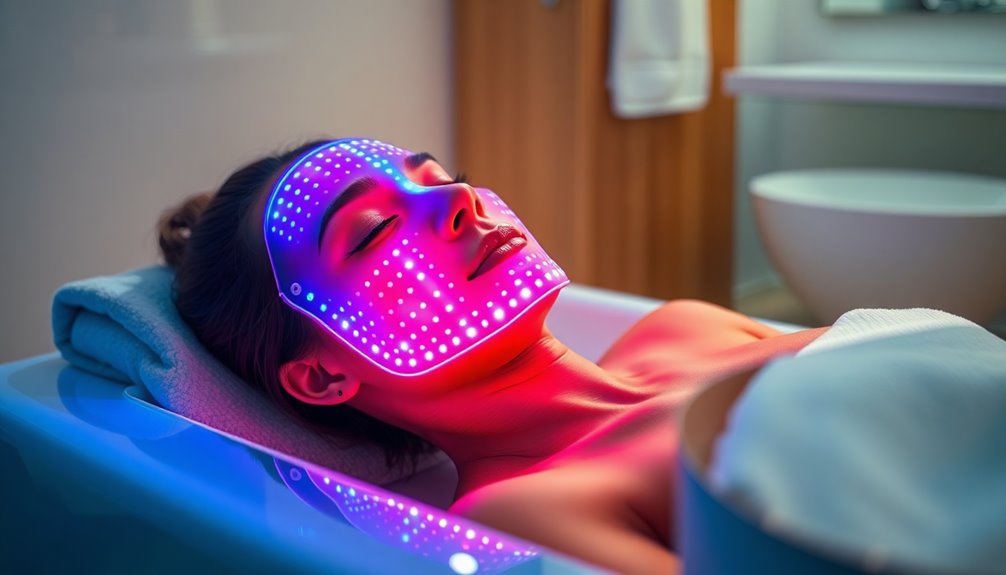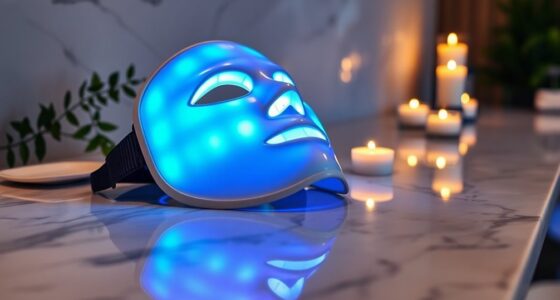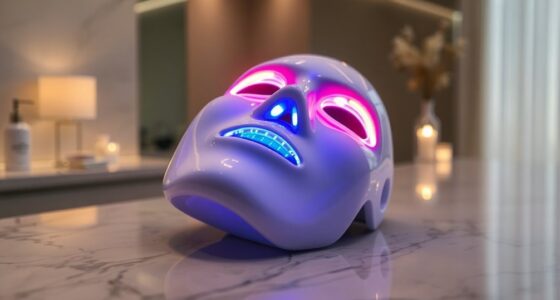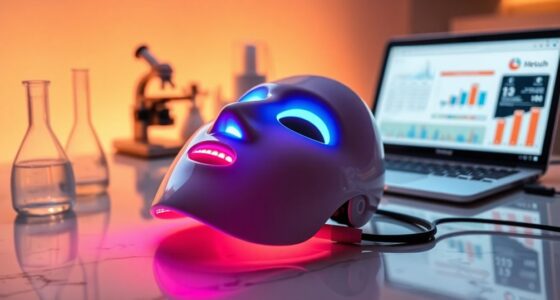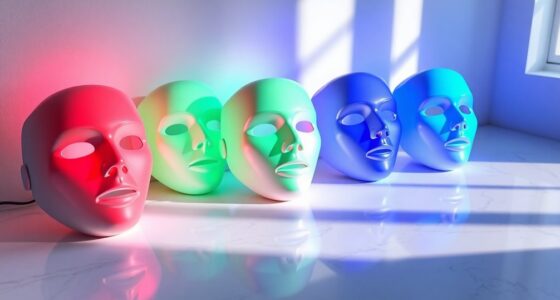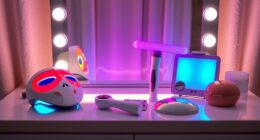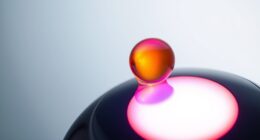LED face masks rejuvenate your skin by using specific light wavelengths. Red light boosts collagen production and improves elasticity, while blue light targets acne-causing bacteria, helping clear breakouts. Near-infrared light penetrates deeper for enhanced healing. Regular use promotes a plumper, more radiant complexion and reduces fine lines over time. You’ll want to know how to properly use these masks and what to expect, so stick around for more details on maximizing their benefits.
Key Takeaways
- LED face masks use specific light wavelengths to enhance collagen production and improve skin elasticity, leading to a more youthful appearance.
- Blue light therapy targets acne by killing bacteria and regulating oil production, helping to clear breakouts and reduce blemishes.
- Red light therapy reduces inflammation, improves microcirculation, and promotes healing, resulting in healthier and rejuvenated skin.
- Near-infrared light penetrates deeper layers for enhanced cell turnover, contributing to overall skin rejuvenation and improved texture.
- Consistent use of LED masks (5-20 minutes daily) can lead to cumulative benefits, enhancing hydration and promoting a radiant complexion over time.
Understanding LED Face Masks

When you think about enhancing your skincare routine, LED face masks might just be the game-changer you need.
These innovative devices use specific wavelengths of light, like red and blue, to promote biochemical reactions in your skin. Red light therapy, ranging from 630 to 660 nanometers, boosts collagen synthesis and improves microcirculation, making your skin look younger and healthier.
On the other hand, blue light therapy, at 405 to 420 nanometers, targets acne by killing bacteria and regulating oil production.
With consistent use of at-home LED masks for just 5-20 minutes daily, you can reduce inflammation, improve skin conditions, and achieve better texture and hydration.
Regular application leads to noticeable improvements over time, enhancing your overall appearance.
How LED Light Therapy Works
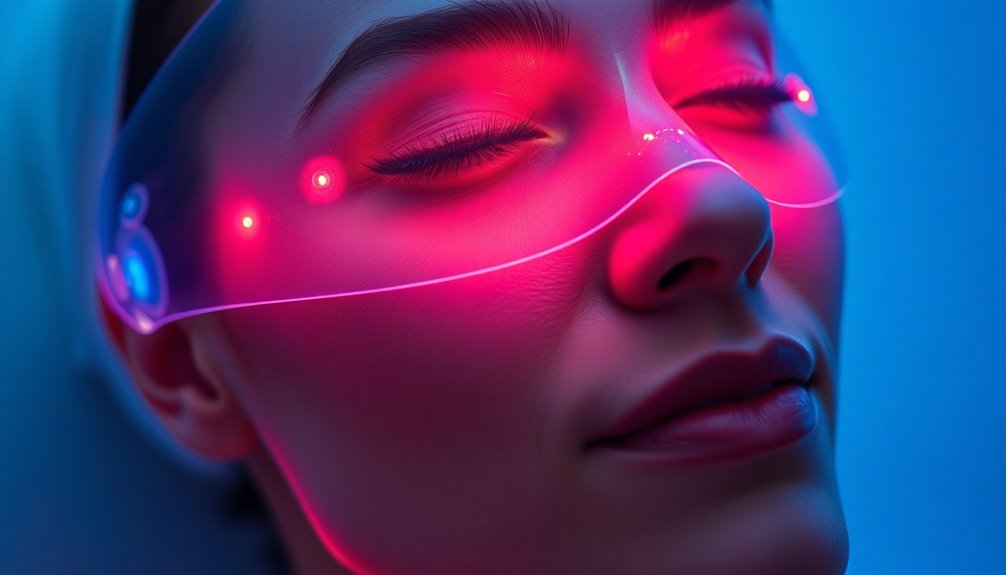
LED light therapy uses specific wavelengths to penetrate your skin, stimulating cellular activity for healthier skin.
Red and blue lights target different concerns—red light reduces inflammation while blue light fights acne-causing bacteria.
Understanding how these wavelengths work and their effects on your skin can help you choose the right treatment for your needs.
Wavelengths and Skin Penetration
While many skincare treatments promise results, LED light therapy stands out due to its specific wavelengths that penetrate the skin at varying depths. Red light LED, ranging from 630 to 660 nanometers, effectively stimulates collagen production and reduces wrinkles. Near-infrared light, with wavelengths from 800 to 1,400 nanometers, penetrates deeper, enhancing cell turnover and promoting healing in deeper layers. Blue light targets acne-causing bacteria, helping to clear breakouts. The effectiveness of LED light therapy relies on using the right wavelengths, so quality matters. Here’s a quick overview:
| Light Color | Wavelength Range (nm) | Main Benefit |
|---|---|---|
| Red Light | 630 – 660 | Collagen production |
| Near-Infrared Light | 800 – 1,400 | Deep skin healing |
| Blue Light | 405 – 420 | Kills acne-causing bacteria |
Mechanism of Action
By harnessing specific wavelengths of light, LED light therapy effectively stimulates cellular activity in your skin.
Red light therapy, with wavelengths from 630 to 660 nanometers, boosts collagen and elastin production while reducing inflammation and enhancing skin elasticity. This promotes healing and rejuvenation, giving your skin a more youthful appearance.
On the other hand, blue light therapy, ranging from 405 to 420 nanometers, targets acne-causing bacteria, helping to clear breakouts and prevent future ones.
Additionally, near-infrared (NIR) light penetrates deeper, with wavelengths between 800 to 1,400 nanometers, further enhancing collagen production and accelerating cell turnover.
Consistent use of LED light therapy leads to cumulative effects, resulting in noticeable improvements in your skin’s texture and tone over time.
Treatment Types and Effects
To achieve ideal skin benefits, understanding the different types of LED light therapy is essential. Each therapy targets specific skin concerns and promotes visible improvements.
- Red Light Therapy: This type boosts collagen production, reduces inflammation, and helps heal fine lines and wrinkles.
- Blue Light Therapy: It effectively tackles acne-causing bacteria, regulating oil production to clear breakouts.
- Near-Infrared Light: Penetrating deeper layers, it stimulates collagen and elastin production, enhancing overall skin texture and elasticity.
Consistent use of LED masks, typically for 5-20 minutes daily, leads to cumulative benefits.
While at-home devices can be effective, professional treatments often yield more significant results, ensuring you get the most out of your skincare routine.
Benefits of Using LED Face Masks

LED face masks are revolutionizing skincare routines with their impressive benefits. By utilizing specific wavelengths of light, these masks promote collagen production, which can help reduce fine lines and improve skin elasticity.
Regular use enhances skin hydration, making your complexion look plumper and more radiant. Red light therapy, a key feature of many LED masks, decreases inflammation and offers significant anti-aging benefits, helping you achieve a youthful glow.
Additionally, LED face masks target acne lesions effectively, reducing blemishes and accelerating healing. Just 5-20 minutes a day can lead to noticeable improvements in your skin texture and overall appearance.
Incorporating LED face masks into your routine can transform your skincare experience and deliver impressive results over time.
Different Types of LED Light and Their Effects

When it comes to LED face masks, different types of light offer unique benefits for your skin.
Red light can boost collagen production and reduce inflammation, while blue light targets acne-causing bacteria.
Near-infrared light penetrates deeper, enhancing overall skin rejuvenation, making it essential to choose the right light for your needs.
Red Light Benefits
While you explore the benefits of different types of LED light therapy, red light stands out for its remarkable impact on skin health.
Red light therapy, with wavelengths between 630 and 660 nanometers, effectively addresses various skin concerns. Here are three key benefits:
- Boosts collagen production: It helps reduce the appearance of fine lines and wrinkles.
- Enhances healing: Regular use accelerates healing processes, improving skin texture over time.
- Improves microcirculation: This promotes better blood flow, delivering essential nutrients to skin cells.
Moreover, red light therapy is generally safe for most skin types and can be used alongside other treatments for enhanced results.
Embrace its potential to transform your skin!
Blue Light Effects
Blue light therapy offers a powerful solution for those struggling with acne and skin inflammation. Operating within the wavelength range of 405 to 420 nanometers, blue light effectively targets and kills acne-causing bacteria on your skin.
By reducing inflammation and regulating oil production, it helps prevent future breakouts and enhances overall skin clarity. Research shows that regular use can lead to significant reductions in acne lesions, making it a popular choice for people with acne vulgaris.
Unlike red light, which focuses on anti-aging benefits, blue light specifically addresses active acne issues. Over time, consistent use can improve your skin texture and decrease the frequency of breakouts, giving you the clearer, healthier skin you desire.
Near-Infrared Advantages**
After exploring the benefits of blue light therapy, it’s clear that different types of LED light can offer unique advantages for your skin.
Near-infrared (NIR) light, for instance, penetrates deeper layers, stimulating collagen and enhancing skin elasticity.
Here are three key benefits of NIR light therapy:
- Improved Wound Healing: NIR enhances blood circulation, accelerating nutrient delivery and promoting healing in damaged tissues.
- Reduced Inflammation: It effectively diminishes redness and inflammation, making it ideal for sensitive skin or conditions like rosacea.
- Youthful Complexion: Regular use of NIR in LED masks leads to cumulative effects, resulting in a more rejuvenated and youthful complexion over time.
Incorporating NIR light into your routine can greatly elevate your skincare results.
Recommended Usage Guidelines

To achieve the best results with your LED face mask, it is crucial to follow recommended usage guidelines. Typically, sessions last between 5 to 20 minutes, with a frequency of 3 to 5 times a week for ideal results. Always wash and dry your face beforehand to guarantee effective skin penetration.
| Session Duration | Frequency | Post-Treatment Action |
|---|---|---|
| 5-20 minutes | 3-5 times a week | Apply hydrating skincare products |
| Pre-clean face | Avoid irritants | Document skin condition progress |
Potential Risks and Side Effects

While LED face masks can offer impressive benefits for your skin, it’s important to be aware of potential risks and side effects. Here are a few to take into account:
- Irritation: Overusing the mask or using it incorrectly may lead to redness or increased inflammation, especially for those with sensitive skin.
- Eye Protection: Using blue light can pose risks to your vision, so always prioritize eye protection during treatments to avoid damage.
- Skin Type Considerations: Users with darker skin tones might experience discoloration or irritation, so it’s essential to follow manufacturer instructions and consult a dermatologist if needed.
To guarantee safe usage, always adhere to the recommended guidelines and be mindful of your skin type when choosing LED colors.
User Experiences and Results
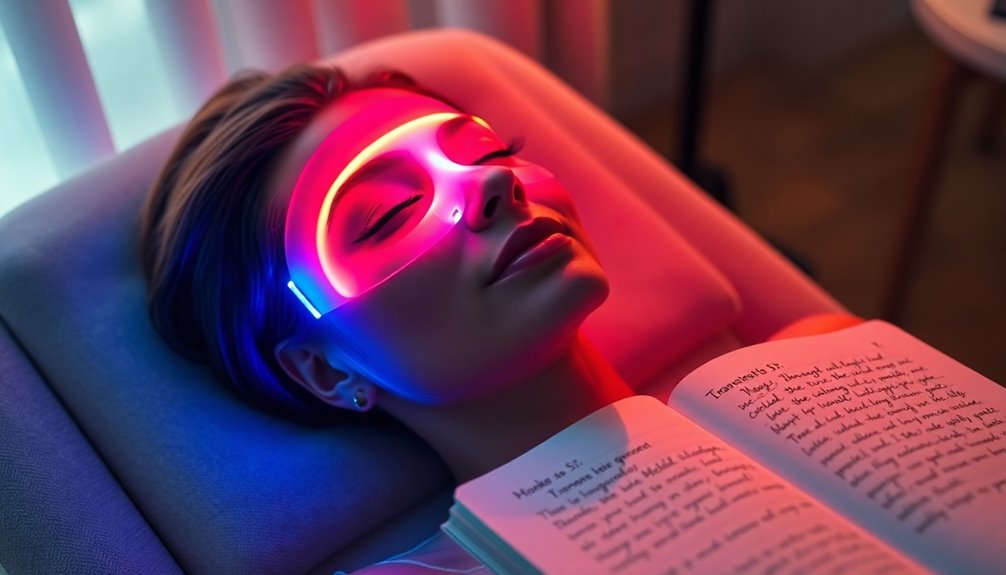
How do LED face masks deliver tangible results for users? Many individuals report seeing dramatic improvements in their skin after consistent use.
With regular application of red and near-infrared light therapy, you might notice enhanced hydration and firmness due to increased collagen production. Users often highlight subtle improvements in skin texture, fine lines, and wrinkles after about a month of treatment.
Furthermore, the blue light therapy effectively targets acne lesions, leading to clearer skin and reduced redness. Incorporating these masks into your skin care routine is easy and relaxing, making it convenient to multitask.
For best results, aim for 5-20 minutes daily, as documented experiences emphasize the importance of consistent use for cumulative benefits.
Comparing At-Home and Professional Treatments

Many users find LED face masks a convenient addition to their skincare routines, but it’s important to understand the differences between at-home devices and professional treatments.
Here’s what you should consider:
- Intensity: Professional treatments use higher-powered devices, offering deeper light penetration for serious skin conditions, while at-home devices often focus on one or two wavelengths.
- Efficacy: Clinical studies back professional treatments more extensively, and many are FDA cleared, ensuring effectiveness for visible results.
- Results Timeline: At-home light therapy masks require regular use for weeks to show subtle improvements, whereas professional treatments can yield immediate effects.
If you’re dealing with severe acne or deep wrinkles, professional treatments are recommended to achieve the best results.
Frequently Asked Questions
Do LED Face Masks Actually Work?
Yes, LED face masks can actually work, but results vary.
You might notice improvements in skin texture and a healthy glow with regular use, typically about five times a week. It can take a month or more to see visible changes, so patience is key.
Just remember to follow the manufacturer’s instructions carefully and use eye protection, especially during blue light therapy, to avoid irritation.
Consistency is essential for getting the best results.
How Often Should You Use a LED Face Mask?
You should use a LED face mask about five times a week, with each session lasting 10 to 20 minutes.
Consistency is key, so stick to this routine for at least a month to see the best results.
Keep in mind the manufacturer’s guidelines to avoid irritation.
After about four to six weeks of regular use, you’ll likely notice improvements in your skin’s texture and overall appearance.
What Are the Disadvantages of LED Mask?
When you consider using an LED mask, it’s important to be aware of its disadvantages.
You might experience irritation, redness, or increased inflammation if you use it too much or without proper guidance. The at-home versions are generally less powerful, which can lead to less noticeable results over time.
Plus, some people find blue light irritating, especially those with sensitive skin.
Always remember that results can vary depending on your skin type and condition.
How Long Does It Take to See Results From a LED Mask?
Imagine your skin as a garden, waiting to bloom. When you use an LED mask, you’ll likely see initial improvements, like a radiant glow, within a week or two.
However, for those deeper changes—like reduced wrinkles or clearer skin—you’ll need to stick with it for four to six weeks, ideally using it five times a week for 10-20 minutes.
Track your progress with photos, since subtle shifts can be hard to spot daily.
Conclusion
To sum up, LED face masks can be a game-changer for your skincare routine, offering benefits like reduced acne and improved skin tone. Did you know that studies show 80% of users report noticeable results within just a few weeks? By understanding how different light wavelengths work and following recommended guidelines, you can effectively enhance your skin’s health from the comfort of home. So, why not give it a try and see the difference for yourself?
